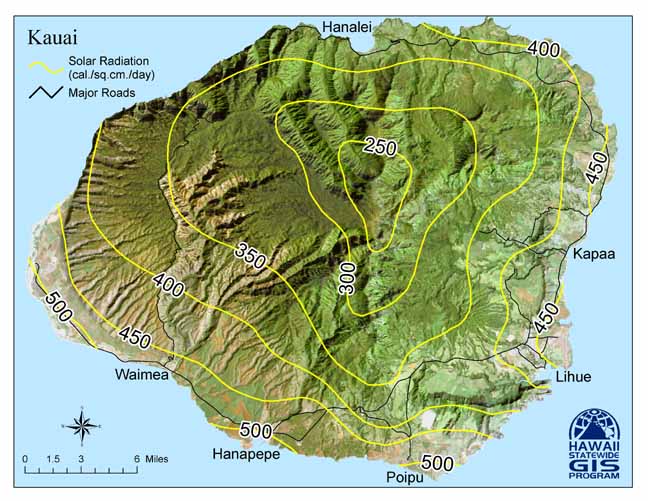SUBJECT: SOLAR ENEGRY
SOURCE: WOLFGANG LANGLOIS langloisl001@hawaii.rr.com
POSTED
12 MAY 2004 - 2:45pm HST
Solar Energy Project: Case Study #1: Phase III Part 2
by Juan Wilson on 12 May 2004
Phase III Part 2
Photovoltaic electricity for net metering with KUIC 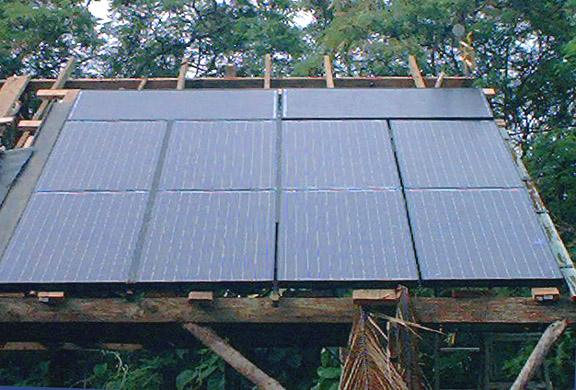 The last solar-voltaic panel is on the roof. Hurray! Now all that is left is rainproofing, wiring and permits. Well, you got to be patient with this, but once it is done, it will just produce and produce energy for years to come.  Waterproofing: The vertical gaps are being covered with a 1/8th flat steel molding, that is screwed onto strips of redwood underneath the steel frame (see picture) and sealed with silicone. The horizontal gaps are filled with dense foam strips, that are topped with a thin layer of silicone. A rain test showed that the panels themselves were not water sealed and also have to be siliconed. SUBJECT: SOLAR ENEGRY SOURCE: WOLFGANG LANGLOIS langloisl001@hawaii.rr.com
POSTED: 29 APRIL 2004 - 8:00am HST
Solar Energy Project: Case Study #1: Phase III Part 1 Phase III part 1
Photovoltaic electricity for net metering with KUIC The 10 Photo-Voltaic (PV) panels will be mounted to the right of the hot-water panels. They should produce a nominal 1600 Watts.Rumour has it that under an intense tropical sun the actual power output might be 20 to 30 % higher. We will see. The first 3 panels have gone up on, mounted onto a 1⁄4 “ flat steel frame, that I pre-assembled with the panels on the ground. I welded diagonal braces between the tracks to create a rigid structure that could be moved onto the rafters without warping or distorting. Later bolted tightly to the roof this would also add strength to withstand high wind gusts.
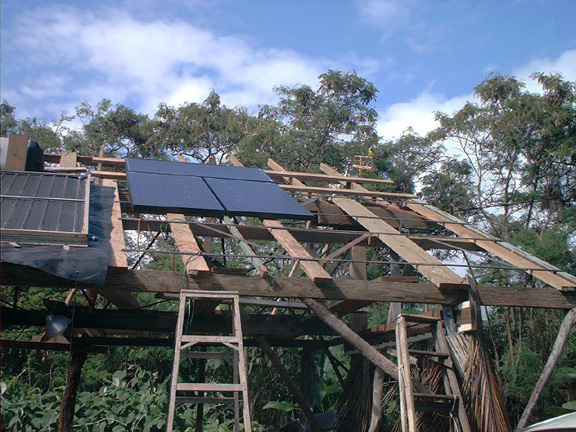 The steel solution was about half price compared to the prefab mounting tracks made out of aluminum and is certainly stronger . Some planning had to be done to guarantee easy and quick access to the mounting screws of the panels in order to remove them in a hurricane. The other nut to crack was how to seal the 1 inch distance between the panels to create a rainproof area underneath for storage. 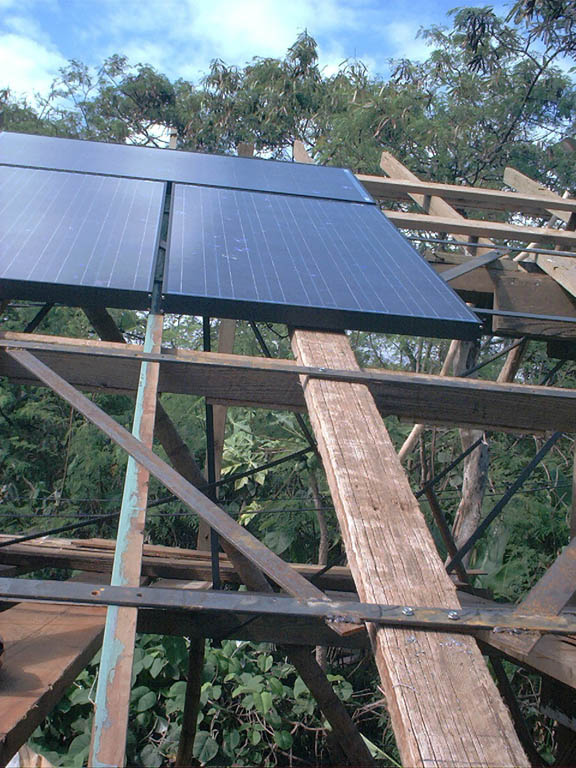 .
SUBJECT: SOLAR ENEGRY Solar
Energy Project: Case Study #1: Phase I & Phase
II
SOURCE: WOLFGANG LANGLOIS langloisl001@hawaii.rr.com
POSTED: 15 APRIL 2004 - 9:00am HST
 Progress report on a private Solar-Voltaic Net-Metering project on the Westside.
Phase I
Building of a separate structure in the sunniest location on the property To achieve most sun hours on a winter day. Materials: Natural hardwood poles Treated lumber Steel elements This project will not include energy storage, but will be "net-metered" with the electric utility, KUIC. The structure that I designed is free standing and not simply laid on my existing home's roof. I wanted to provide a drive through carport that could shade my truck as well as allow continued access to my back yard. The location was chosen also because the power hookup for the
house passes right behind the structure. This will be handy when it's time to connect the net-metering box.
The optimum angle of the panels, and therefore the frame supporting them, is 35 degrees. The optimum orientation for solar load is due south. However, the loss of energy is negligible within 5 degrees of south. You may choose to twist the orientation east or west depending on the time of day you want the most hot water. You also may have to adjust the orientation if you have interference
with the sun from the surrounding landscape or buildings. In my case the orientation for the structure was chosen to maximize solar energy relative to surrounding trees.
The aesthetic for this project is "Rustic Pacific Island". Note I am using palm fronds as a decorative motif. Many of the the columns are driftwood I found washed up onto southshore beaches. I chose pieces that were hardwood and well worn by the sea. Deep postholes were dug and backfilled with rock and cement for durability.
Using new, wet lumber for the rafters it okay if you wait until the wood has adjusted to the dry and hot west side climate, since warping of the wood could tear up the panels. Warranty demands the panels to be mounted on a metal frame. 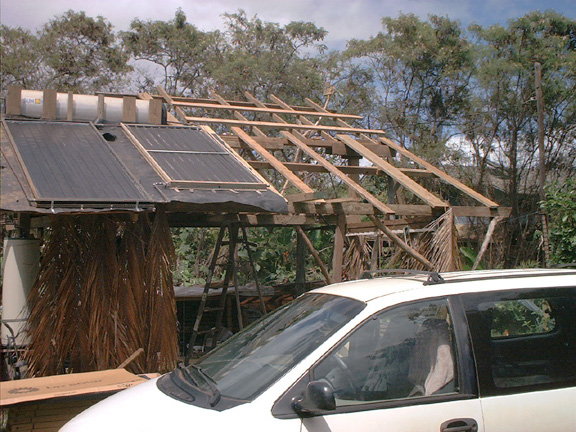 Phase II Hot water system from recycled panels and containers, no moving parts. Two hours of sunlight is sufficient for an average household. At this point the hot water heating panels are already installed. These are recycled panels. Knowing how to sweat copper piping together is the only real skill needed for this. Note the gas hot-water-heater mounted on a small platform to the left of carport structure. There is a propane tank and electric pump next to it. Under the panels is a tough plastic liner I recycled from the shrimp
farm in Kekaha. It is quite tough and will be used as a waterproof sheath for the ten Photo-Voltaic (PV) panels that will be going up on the frame soon. If you look, you can see the stack of panels, still in boxes, in front of the van.
SUBJECT:
SOLAR ENEGRY
Solar
Energy Map and Yield Table
SOURCE: JUAN WILSON juanwilson@mac.com
POSTED: 28 JANUARY 2004 - 8:30am HST
For solar energy info check out Hawaii's State Department of Business, Econominc Development & Tourism
The department also operates a Clean Energy Estimator that helps in calculating the cost and savings of installing and operating a residential solar voltaic system. This is quite useful in preliminary sizing and estimatong of a solar system.
Below is a solar insolation map of the island of Kauai.It is available here. This map features estimated insolation isograms (i.e. they show the average amount of solar energy received in a particular area) over a relief a map of the island, so physical features such as mountains can be referenced easily. Major roads are also shown.
Solar radiation is given in langleys (calories per square centimeter per day). The map is intended for general information and for use in sizing solar water heating systems, but may not be specific enough for more demanding applications, such as sizing photovoltaic installations.
SUBJECT:
SOLAR ENEGRY
SOURCE: WOLFGANG LANGLOIS langloisl001@hawaii.rr.com POSTED: 23 JANUARY 2004 - 11:30am An
invitation to compare solar energy notes
Wake up Kauai to your solar future!
I wish everybody would know already, that net metering is the quantum leap that takes the bitterness out of alternative energy: NO MORE BATTERIES! |
||||||||||||||||||||||||||||||||||||||||||||||||||||||||||||||||||||||||||||||||
